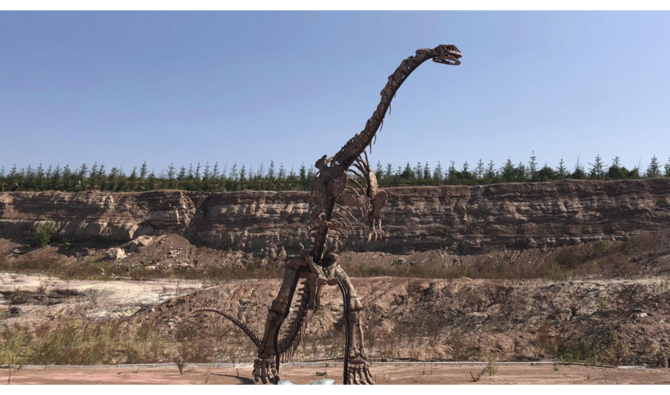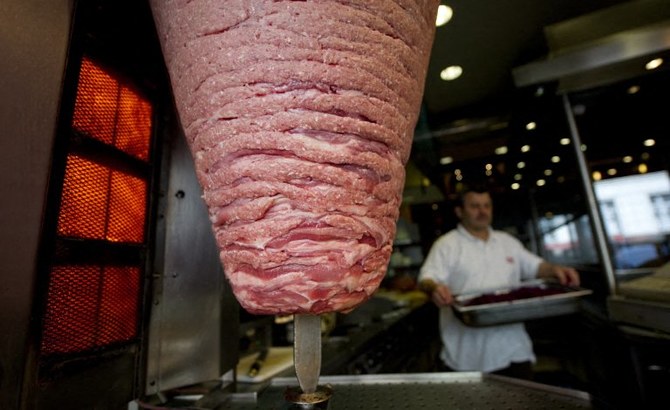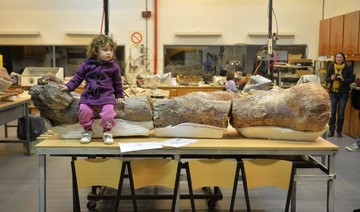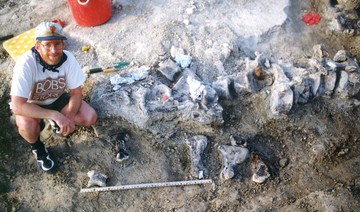YANJI, China: At the end of a street of newly built high-rises in the northern Chinese city of Yanji stands an exposed cliff face, where paleontologists scrape away 100 million-year-old rock in search of prehistoric bones.
Like many fossil excavation sites in China, this one was discovered by accident.
China’s rapid city building has churned up a motherlode of dinosaur fossils. While bulldozers have unearthed prehistoric sites in many countries, the scale and speed of China’s urbanization is unprecedented, according to the United Nations Development Program.
Perhaps no one has seized the scientific opportunity more than Xu Xing, a diligent and unassuming standard-bearer for China’s new prominence in paleontology. The energetic researcher has named more dinosaur species than any living paleontologist, racing between dig sites to collect specimens and further scientists’ understanding of how birds evolved from dinosaurs.
Matthew Lamanna, a curator at the Carnegie Museum of Natural History in Pittsburgh, said Xu is “widely regarded as one of the foremost, if not the foremost, dinosaur paleontologist working in China today.”
“Xu Xing is A-M-A-Z-I-N-G,” Kristina Curry Rogers, a paleontologist at Macalester College in St. Paul, Minnesota, wrote in an email.
Two years ago, Xu’s colleague at the Chinese Academy of Sciences in Beijing, Jin Changzhu, was visiting family in Yanji when he heard talk of fossils uncovered at a construction site. A preliminary inspection yielded what appeared to be a dinosaur shoulder bone.
Less than an hour’s drive from the North Korean border, the midsize city has been erecting residential blocks quickly. Seen from a plane, Yanji looks like a Legoland of new pink- and blue-roofed buildings, but there’s one long empty lot of exposed rocky hillside — the excavation site.
When Xu arrived at Yanji, he recognized the site could fill gaps in the fossil record, noting the relative paucity of bones recovered from the late Cretaceous period, which was around 100 million years ago. An analysis of the layers of volcanic ash revealed the site’s age. Xu is now overseeing a team of scientists using picks, chisels and steel needles to study the exposed hillside, where geologic layers resemble a red and gray layer-cake.
The site has yielded partial skeletons of three ancient crocodiles and one sauropod, the giant plant-eating dinosaurs that included some of the world’s largest land animals.
“This is a major feature of paleontology here in China — lots of construction really helps the scientists to find new fossils,” said Xu as he used a needle to remove debris from a partially exposed crocodile skull.
Born in 1969 in China’s western Xinjiang region, Xu did not choose to study dinosaurs. Like most university students of his era, he was assigned a major. His love for the field grew in graduate school in the 1990s, as feathered dinosaurs recovered from ancient Chinese lakebeds drew global attention.
When Xu and Jin discovered fossils in Yanji in 2016, city authorities halted construction on adjacent high-rise buildings, in accordance with a national law.
“The developer was really not happy with me,” said Xu, but the local government has since embraced its newfound claim to fame.
The city is now facilitating Xu’s work, and even built an on-site police station to guard the fossils from theft. Once the excavation is complete, a museum is planned, to display recovered fossils and photos of Xu’s team at work.
It’s not the first museum to commemorate Xu, whose prodigious fieldwork has taken him across China and resulted in a flurry of articles in top scientific journals.
Toru Sekiyu, a paleontologist from the Fukui Prefectural Dinosaur Museum in Japan who assisted on the Yanji dig, called his Chinese colleague “a superstar paleontologist.”
But Xu is quick to point out the role that good fortune has played in his career.
“To publish papers and discover new species, you need new data — you need new fossils,” he said, adding that finding new species isn’t something a scientist can plan.
“My experience tells me that you really need luck, besides your hard work. Then you can make some important discoveries.”
With digs in Inner Mongolia, Liaoning, Yunnan and other Chinese provinces, Xu patiently oversees excavations, sometimes chiseling for years before he knows their ultimate significance.
While his finds are wide-ranging, much of his career has focused on understanding how dinosaurs evolved into modern birds.
China is an ideal location for that study. Two decades ago, rare dinosaur fossils that preserved traces of feathers were found in ancient lakebeds of northeastern China. This discovery, which helped scientists demonstrate that birds descended from dinosaurs, was possible because the mixture of volcanic ash and fine-grained shale in the lakebeds had preserved bits of soft tissue, including feathers — unlike the majority of dinosaur fossils, which contain only bone.
Since then, a flood of new dinosaur bones unearthed in China has helped scientists rewrite their understanding of the tree of life in various ways.
Xu has been at the forefront of research into how dinosaurs evolved feathers and flight. In 2000, he described a curious pigeon-sized dinosaur with four feathered limbs, apparently early wings that allowed the animal to either fly or glide. In 2012, he detailed a carnivorous tyrannosaur , which also had plumage — raising questions about feathers’ original purpose.
Xu now believes that early dinosaur plumage may have played a role in insulation and in mating displays, even before flight feathers evolved. He co-authored a 2010 paper that examined fossilized melanosomes — pigment packets that give rise to color in modern bird feathers — to deduce the likely colors of dinosaur feathers. Some species likely sported rings of white and brown tail feathers; others had bright red plumage on their heads.
Embracing new technology, his team also uses CT scanners to study the interior of fossils and builds 3-D computer simulations to make inferences about what range of motions a dinosaur may have had.
One of the fossils Xu is now examining, found at a construction site in Jiangxi province, will shed light on how modern birds’ reproductive systems evolved from dinosaurs, he says.
In addition to professional accolades, Xu’s work has attracted attention from schoolchildren in multiple countries, who mail him handwritten notes and crayon drawings of dinosaurs, several of which hang in his Beijing office.
Xu replies to every letter, email and text message with a question about dinosaurs. “I feel it would be weird or impolite not to,” he said. But in an era of social media, Xu has refrained from signing up for WeChat, the dominant messaging platform in China, because “I don’t think I could find time for all the new messages.”
Back at the site in Yanji, a colleague brings him a large rock with an exposed sauropod vertebrae to examine.
The bone has a spongey texture, which Xu says is a result of the animal’s respiratory system. Like modern birds, he believes sauropods breathed using both lungs and distributed air sacs, which can leave an impression in the bones.
Xu uses a brush to flick away dirt to inspect the fossil more closely.
“Basically we are reconstructing the evolutionary tree of life,” he said. “If you have more species to study, you have more branches on that tree, more information about the history of life on Earth.”
China building boom uncovers buried dinosaurs, makes a star
China building boom uncovers buried dinosaurs, makes a star

- China’s rapid city building has churned up a motherlode of dinosaur fossils
Meaty issue: German political party calls for €4.90 price cap on doner kebabs

- Die Linke appeals to government as price of national favorite hits €10 in some cities
- Scheme would cost taxpayer about €4bn
LONDON: German political party Die Linke has urged the government to cap the price of a much loved food item — the doner kebab.
The party has proposed providing daily vouchers to households that would limit prices to €4.90 ($5.28) and €2.90 for young people under an initiative known as Donerpreisbremse.
The scheme is projected to cost the government about €4 billion.
Introduced after the Second World War by Turkish immigrants who adapted the dish to suit local tastes, the doner kebab is a national favorite in Germany, with an estimated 1.3 billion consumed annually. But their soaring price has become a hot-button political issue.
Die Linke said the cost of a doner kebab had reached €10 in some cities, from €4 just two years ago.
“For young people right now it is an issue as important as where they will move when they leave home,” said Hanna Steinmuller, a lawmaker with the Greens party.
“I know it’s not an everyday issue for many people here … but I think as voter representatives we are obliged to highlight these different perspectives.”
German Chancellor Olaf Scholz was famously confronted by a voter last year who demanded he “speak with Putin … I’m paying €8 for a doner.”
With public pressure mounting, Scholz recently acknowledged on social media that “everywhere I go, mostly by young people, I get asked if there should be a price cap for doner kebabs.”
Despite the appeals, the chancellor rejected the proposal, citing the impracticality of price controls in a free market economy.
Despite its humble origins as a street food, the doner kebab has become an unexpected point of political focus.
Last month, German President Frank-Walter Steinmeier sparked controversy when on a visit to Turkiye he gifted 60 kg of kebab meat from Berlin to Istanbul in what some called a clumsy attempt to symbolize the strong cultural ties between the two nations.
A 98-year-old in Ukraine walked miles to safety from Russians, with slippers and a cane

- Describing her journey, the nonagenarian said she had fallen twice and was forced to stop to rest at some points, even sleeping along the way before waking up and continuing her journey
KYIV, Ukraine: A 98-year-old woman in Ukraine who escaped Russian-occupied territory by walking almost 10 kilometers (6 miles) alone, wearing a pair of slippers and supported by a cane has been reunited with her family days after they were separated while fleeing to safety.
Lidia Stepanivna Lomikovska and her family decided to leave the frontline town of Ocheretyne, in the eastern Donetsk region, last week after Russian troops entered it and fighting intensified.
Russians have been advancing in the area, pounding Kyiv’s depleted, ammunition-deprived forces with artillery, drones and bombs.
“I woke up surrounded by shooting all around — so scary,” Lomikovska said in a video interview posted by the National Police of Donetsk region.
In the chaos of the departure, Lomikovska became separated from her son and two daughters-in-law, including one, Olha Lomikovska, injured by shrapnel days earlier. The younger family members took to back routes, but Lydia wanted to stay on the main road.
With a cane in one hand and steadying herself using a splintered piece of wood in the other, the pensioner walked all day without food and water to reach Ukrainian lines.
Describing her journey, the nonagenarian said she had fallen twice and was forced to stop to rest at some points, even sleeping along the way before waking up and continuing her journey.
“Once I lost balance and fell into weeds. I fell asleep … a little, and continued walking. And then, for the second time, again, I fell. But then I got up and thought to myself: “I need to keep walking, bit by bit,’” Lomikovska said.
Pavlo Diachenko, acting spokesman for the National Police of Ukraine in the Donetsk region, said Lomikovska was saved when Ukrainian soldiers spotted her walking along the road in the evening. They handed her over to the “White Angels,” a police group that evacuates citizens living on the front line, who then took her to a shelter for evacuees and contacted her relatives.
“I survived that war,’ she said referring to World War II. “I had to go through this war too, and in the end, I am left with nothing.
“That war wasn’t like this one. I saw that war. Not a single house burned down. But now – everything is on fire,” she said to her rescuer.
In the latest twist to the story, the chief executive of one of Ukraine’s largest banks announced on his Telegram channel Tuesday that the bank would purchase a house for the pensioner.
“Monobank will buy Lydia Stepanivna a house and she will surely live in it until the moment when this abomination disappears from our land,” Oleh Horokhovskyi said.
Amazon Purr-rime: Cat accidentally shipped to online retailer

- Galena was found safe by a warehouse worker at an Amazon center after vanishing from her home in Utah
LOS ANGELES: A curious cat that sneaked into an open box was shipped across the United States to an Amazon warehouse after its unknowing owners sealed it inside.
Carrie Clark’s pet, Galena, vanished from her Utah home on April 10, sparking a furious search that involved plastering “missing” posters around the neighborhood.
But a week later, a vet hundreds of miles (kilometers) away in Los Angeles got in touch to say the cat had been discovered in a box — alongside several pairs of boots — by a warehouse worker at an Amazon center.
“I ran to tell my husband that Galena was found and we broke down upon realizing that she must have jumped into an oversized box that we shipped out the previous Wednesday,” Clark told KSL TV in Salt Lake City.
“The box was a ‘try before you buy,’ and filled with steel-toed work boots.”
Clark and her husband jetted to Los Angeles, where they discovered Amazon employee Brandy Hunter had rescued Galena — a little hungry and thirsty after six days in a cardboard box, but otherwise unharmed.
“I could tell she belonged to someone by the way she was behaving,” said Hunter, according to Amazon.
“I took her home that night and went to the vet the next day to have her checked for a microchip, and the rest is history.”
What did people eat before agriculture? New study offers insight

- Analysis of forms — or isotopes — of elements including carbon, nitrogen, zinc, sulfur and strontium in these remains indicated the type and amount of plants and meat they ate
WASHINGTON: The advent of agriculture roughly 11,500 years ago in the Middle East was a milestone for humankind — a revolution in diet and lifestyle that moved beyond the way hunter-gatherers had existed since Homo sapiens arose more than 300,000 years ago in Africa.
While the scarcity of well-preserved human remains from the period preceding this turning point has made the diet of pre-agricultural people a bit of a mystery, new research is now providing insight into this question. Scientists reconstructed the dietary practices of one such culture from North Africa, surprisingly documenting a heavily plant-based diet.
The researchers examined chemical signatures in bones and teeth from the remains of seven people, as well as various isolated teeth, from about 15,000 years ago found in a cave outside the village of Taforalt in northeastern Morocco. The people were part of what is called the Iberomaurusian culture.
Analysis of forms — or isotopes — of elements including carbon, nitrogen, zinc, sulfur and strontium in these remains indicated the type and amount of plants and meat they ate. Found at the site were remains from different edible wild plants including sweet acorns, pine nuts, pistachio, oats and legumes called pulses. The main prey, based on bones discovered at the cave, was a species called Barbary sheep.
“The prevailing notion has been that hunter-gatherers’ diets were primarily composed of animal proteins. However, the evidence from Taforalt demonstrates that plants constituted a big part of the hunter-gatherers’ menu,” said Zineb Moubtahij, a doctoral student in archaeology at the Max Planck Institute for Evolutionary Anthropology in Germany and lead author of the study published on Monday in the journal Nature Ecology & Evolution.
“It is important as it suggests that possibly several populations in the world already started to include substantial amount of plants in their diet” in the period before agriculture was developed, added archeogeochemist and study co-author Klervia Jaouen of the French research agency CNRS.
The Iberomaurusians were hunter-gatherers who inhabited parts of Morocco and Libya from around 25,000 to 11,000 years ago. Evidence indicates the cave served as a living space and burial site.
These people used the cave for significant portions of each year, suggesting a lifestyle more sedentary than simply roaming the landscape searching for resources, the researchers said. They exploited wild plants that ripened at different seasons of the year, while their dental cavities illustrated a reliance on starchy botanical species.
Edible plants may have been stored by the hunter-gatherers year-round to guard against seasonal shortages of prey and ensure a regular food supply, the researchers said.
These people ate only wild plants, the researchers found. The Iberomaurusians never developed agriculture, which came relatively late to North Africa.
“Interestingly, our findings showed minimal evidence of seafood or freshwater food consumption among these ancient groups. Additionally, it seems that these humans may have introduced wild plants into the diets of their infants at an earlier stage than previously believed,” Moubtahij said.
“Specifically, we focused on the transition from breastfeeding to solid foods in infants. Breast milk has a unique isotopic signature, distinct from the isotopic composition of solid foods typically consumed by adults.”
Two infants were among the seven people whose remains were studied. By comparing the chemical composition of an infant’s tooth, formed during the breastfeeding period, with the composition of bone tissue, which reflects the diet shortly before death, the researchers discerned changes in the baby’s diet over time. The evidence indicated the introduction of solid foods at around the age of 12 months, with babies weaned earlier than expected for a pre-agricultural society.
North Africa is a key region for studying Homo sapiens evolution and dispersal out of Africa.
“Understanding why some hunter-gatherer groups transitioned to agriculture while others did not can provide valuable insights into the drivers of agricultural innovation and the factors that influenced human societies’ decisions to adopt new subsistence strategies,” Moubtahij said.
Palestinian prisoner in Israel wins top fiction prize

- The mask in the novel’s title refers to the blue identity card that Nur, an archaeologist living in a refugee camp in Ramallah, finds in the pocket of an old coat belonging to an Israeli
ABU DHABI: Palestinian writer Basim Khandaqji, jailed 20 years ago in Israel, won a prestigious prize for Arabic fiction on Sunday for his novel “A Mask, the Color of the Sky.”
The award of the 2024 International Prize for Arabic Fiction was announced at a ceremony in Abu Dhabi.
The prize was accepted on Khandaqji’s behalf by Rana Idriss, owner of Dar Al-Adab, the book’s Lebanon-based publisher.
Khandaqji was born in the Israeli-occupied West Bank city of Nablus in 1983, and wrote short stories until his arrest in 2004 at the age of 21.
He was convicted and jailed on charges relating to a deadly bombing in Tel Aviv, and completed his university education from inside jail via the Internet.
The mask in the novel’s title refers to the blue identity card that Nur, an archaeologist living in a refugee camp in Ramallah, finds in the pocket of an old coat belonging to an Israeli.
Khandaqji’s book was chosen from 133 works submitted to the competition.
Nabil Suleiman, who chaired the jury, said the novel “dissects a complex, bitter reality of family fragmentation, displacement, genocide, and racism.”
Since being jailed Khandaqji has written poetry collections including “Rituals of the First Time” and “The Breath of a Nocturnal Poem.”
He has also written three earlier novels.



















